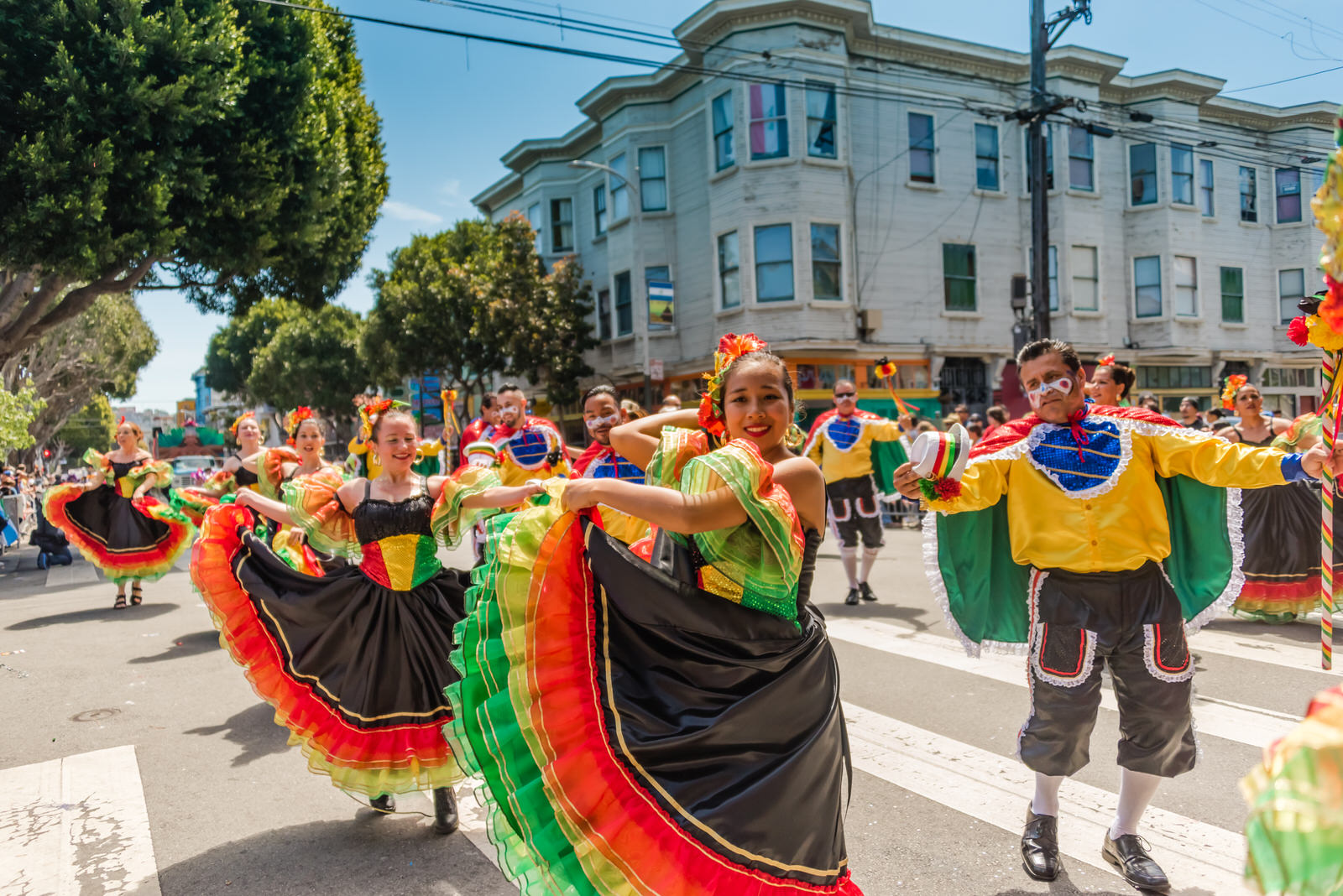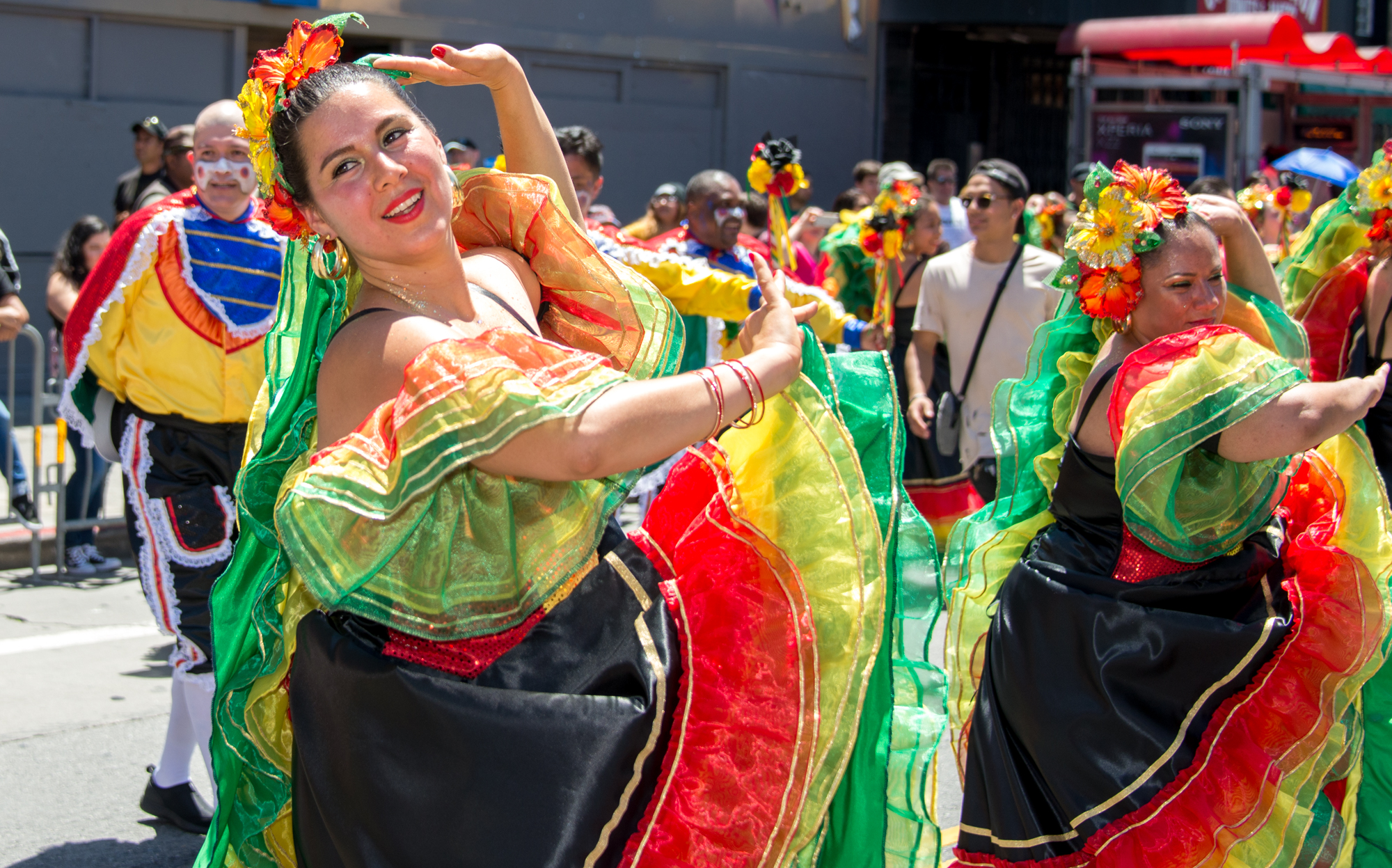It is an early Sunday evening in late March, and I’m sitting on a barstool at Spats in Berkeley where two large screen TVs are showing two different NCAA championship games, but the March Madness action on the screen is being totally ignored by the bar’s patrons.
Instead, dancers in the cavernous middle room are learning choreography they will eventually perform this coming May. But today, Carnaval San Francisco is still in the future and the pressure that will build as the May 26th festival and parade that celebrates the culture of Latin American and the Caribbean approaches has not yet materialized. Today this group of 30 or so people, mostly women wearing red, blue, and yellow skirts over jeans and leggings, are just having fun spending the afternoon together, as they move to the beat holding candles, cups, and empty bottles of Modelo Especial up in one hand, hem of their skirt in the other. Their name is La Cumbiamba Colombiana.
In short order one of the games on the TV ends, the rehearsal ends, and John Jairo Roldán, the group’s director, joins me at another bar in an empty back room. I have caught him at a perfect time for an interview. Clearly still feeling the high of three hours performing the music he loves, but before the inevitable crash, he explains in excited, passionate detail what I have been watching this afternoon.
“La Cumbiamba Colombiana is a folkloric group representing the Afro Caribbean traditions of Colombia. We are doing the Cumbia, a very popular rhythm played from Mexico to Argentina and throughout the Caribbean, but it was born in Colombia,” Roldán explains, continuing that “what we’re trying to do is to bring Cumbia out in a raw and organic way—to show [how] it was played 400 years ago. Every country has put a little twist to it, their own rhythm pattern.” He emphasizes to me that, simple and beautiful, “Cumbia is the mother of all rhythm.”
This will be La Cumbiamba’s sixth time participating in Carnaval. In those six years, they’ve had some success. Roldán shares that “we feel really proud that among 84 dance troupes, back in 2016 we were ranked first by the judges—these are people that know a lot about a folkloric dance and music from the Caribbean and in Latin America.” They were ranked third last year, and are working hard to be ranked high this year.
Roldán stops mid-boast to remind both him and myself that “it’s really not a competition. What we’re trying to do is to share this spirit of Carnaval, so people can learn about our culture or tradition and feel invited to participate.” And he shares that dancing on the street is where Cumbia properly belongs: “That’s what the cumbiamba is. That word has a meaning, it’s when people get together and say, “we’re going to play a cumbiamba, on that corner on this day, and the drummers and the dancers get together, and…” Roldán smiles wistfully and doesn’t finish his sentence as he glimpses some magical memory in his mind’s eye. I don’t ask him to try and put it into words.

Colombia has a Pacific and an Atlantic coastal region, and the cumbia is from the Atlantic side. It was born out of a mixture of the music that was brought to the region by enslaved Africans combined with the music from Indigenous people of the region, who themselves were often enslaved by Spanish colonists. According to Roldán, this is why the music I heard in the rehearsal included drumming that was African in origin as well as flutes that came from the native population. He tells me “that’s the only thing they had. Just to play, to lay out all their mutual sorrow and their anger. And that’s how cumbia was born over 400 years ago.” Today he is part of a Colombian community in the Bay Area trying to keep the cumbia in a pure and beautiful form.
Sparing me from broaching a delicate subject regarding the way many Americans tend to see his home country, he proactively tells me that “you know the media…sometimes they focus a little too much on the negative. When people from other countries hear about Colombia, the first thing that comes to mind is cocaine…[and] this war between the government and the guerilla that’s been going on for 50 years.” He continues, “I’m from a city and in the cities, we don’t know war…people who live in the rural areas, the campesinos, they are the ones who are suffering.” The tenuous peace deal that formally ended the war a few years ago has recently come under review by a new government and some have wondered if it will hold.
The piece that La Combiamba Colombiana is rehearsing is a response to this current situation. Roldán tells me that “the entire company will be dressed in white as a symbol of peace…the main thing that we want to do with our compasa [is] to represent that wish of peace for Colombia.”
I’ve talked to a lot of people about their path to leadership within a dance company and for many there seems to be a pretty common sequence. You’re a member of a group and you love it, and then you start helping out with little things here and there, just to keep the company moving along. And then one day the only person doing all of the little things is you and somebody asks you what they can do to help out, and congratulations: you’ve just become leader of a dance company. As Roldán shares with me, the path was somewhat similar, but infused with more urgency:
“I’ve been a percussionist doing salsa music, playing bongo, minor percussion with many different orchestras. I’ve been participating in Carnaval San Francisco as volunteer drummer for almost 20 years.” One day Carnaval Executive Director Roberto Hernandez reached out to Roldán with the news that there were no Colombian companies performing in that year’s Carnaval. “The conversation with him was that, ‘hey, you know, Colombia is not going to be here. It’s really crucial that you guys participate. I know you can do it…and I will support you every step of the way.” So with that vote of confidence and support, Roldán put together a group to participate in Carnaval and “it’s been now six years and we’re still working on it. And there’s always room for improvement and growing.”
This is something that could only happen in the Bay Area: Roldán shares with me his belief that the Bay Area’s culture is unlike anywhere else in the country, even cities like New York and Miami, where more Colombians reside. The music from the front of the bar has picked up again, despite the rehearsal’s conclusion and as Roldán looks back toward the direction the music is coming from, he concludes “that being in the Bay Area is the blessing, it’s like the universe conspired to bring us all here.”
If you aren’t able to make it to Carnaval this year, you can still see La Cumbiamba Colombiana this May in a venue that is both more intimate and more monumental than Mission street when they perform at the Rotunda Dance Series on Friday, May 24 at San Francisco’s City Hall. He tells me that in the Rotunda they will present cumbia in its most pure form. This includes the Carnaval piece with the dancers in white, as well as other traditional dances. Roldán tells me that they “want to show the people that this is very old and it’s something worth preserving and sharing with the world.” A simple goal, but sharing and sustaining the mother of all rhythms is vitally important.
This article appeared in the May 2019 issue of In Dance.


